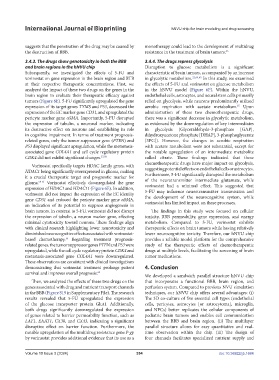Page 362 - IJB-10-3
P. 362
International Journal of Bioprinting hNVU chip for brain modeling and drug screening
suggests that the penetration of the drug may be caused by monotherapy could lead to the development of multidrug
the destruction of BBB. resistance in the treatment of brain tumors. 63
3.4.3. The drugs show genotoxicity in both the BBB 3.4.4. The drugs repress glycolysis
and brain regions in the hNVU chip Disruption to glucose metabolism is a significant
Subsequently, we investigated the effects of 5-FU and characteristic of brain tumors, accompanied by an increase
vorinostat on gene expression in the brain region and BTB in glycolytic metabolism. 22,64,65 In this study, we examined
at their respective therapeutic concentrations. First, we the effects of 5-FU and vorinostat on glucose metabolism
analyzed the impact of these two drugs on the genes in the in the hNVU model (Figure 6F). Within the hNVU,
brain region to evaluate their therapeutic efficacy against endothelial cells, astrocytes, and neural stem cells primarily
tumors (Figure 6E). 5-FU significantly upregulated the gene relied on glycolysis, while neurons predominantly utilized
expression of its target genes TYMS and P53, decreased the aerobic respiration with acetate metabolism. Upon
25
expression of the EC marker gene CD31, and upregulated the administration of these two chemotherapeutic drugs,
pericyte marker gene αSMA. Importantly, 5-FU disrupted there was a significant decrease in glycolytic metabolism,
the expression of tubulin, a neuronal marker, indicating as evidenced by the downregulation of key intermediates
its destructive effect on neurons and establishing its role in glycolysis (Glyceraldehyde-3-phosphate [GAP],
in cognitive impairment. In terms of treatment prognosis- dihydroxyacetone phosphate [DHAP], 3-phosphoglycerate
related genes, only the tumor suppressor gene (PTEN) and [3PG]). However, the changes in aerobic respiration
P53 displayed significant upregulation, while the metastasis- with acetate metabolism were not substantial, except for
associated gene COL4A1 and cell cycle regulatory protein the notable upregulation of an intermediate metabolite
CDK4 did not exhibit significant changes. 57,58 called citrate. These findings indicated that these
chemotherapeutic drugs have major impact on glycolysis,
Vorinostat specifically targets HDAC family genes, with
HDAC1 being significantly overexpressed in glioma, making suggesting potential effects on endothelial cells or astrocytes.
it a crucial therapeutic target and prognostic marker for Furthermore, 5-FU significantly disrupted the metabolism
glioma. 59-61 Vorinostat effectively downregulated the gene of the neurotransmitter intermediate glutamate, while
vorinostat had a minimal effect. This suggested that
expression of HDAC1 and HDAC11 (Figure 6E). In addition, 5-FU may influence neurotransmitter transmission and
vorinostat did not impact the expression of the EC identity the development of the neurocognitive system, while
gene CD31 and reduced the pericyte marker gene αSMA, vorinostat has limited impact on these processes.
an indication of its potential to suppress angiogenesis in
brain tumors. In contrast to 5-FU, vorinostat did not disrupt The findings in this study were focused on cellular
the expression of tubulin, a neuron marker gene, effecting toxicity, BBB permeability, gene expression, and energy
minimal cytotoxicity toward neurons. These findings align metabolism. Compared to 5-FU, vorinostat exhibits
with clinical research highlighting lower neurotoxicity and therapeutic effects on brain tumors while having relatively
diminished neurocognitive effects associated with vorinostat- lower neurocognitive toxicity. Therefore, our hNVU chip
based chemotherapy. Regarding treatment prognosis- provides a reliable model platform for the comprehensive
16
related genes, the tumor suppressor genes PTEN and P53 were study of the therapeutic effects of chemotherapeutic
upregulated, while the cell cycle regulatory protein CDK4 and drugs at multiple levels, facilitating the screening of brain
metastasis-associated gene COL4A1 were downregulated. tumor medications.
These observations are consistent with clinical investigations
demonstrating that vorinostat treatment prolongs patient 4. Conclusion
survival and improves overall prognosis. 62 We developed a sandwich parallel structure hNVU chip
Then, we analyzed the effects of these two drugs on the that incorporates a functional BBB, brain region, and
genes associated with drug and nutrient transport channels perfusion system. Compared to previous NVU simulation
in the BBB (Figure S19 in Supplementary File). The research techniques, our hNVU chip offers several advantages: (i)
results revealed that 5-FU upregulated the expression The 3D co-culture of five essential cell types (endothelial
of the glucose transporter protein Glut1. Additionally, cells, pericytes, astrocytes [or astrocytoma], microglia,
both drugs significantly downregulated the expression and NPCs) better replicates the cellular components of
of genes related to barrier permeability function, such as pediatric brain tumors and enables cell communication
LAT1, EAAT1, CX30, and CX43, indicating a significant between the BBB and brain region. (ii) The multilayer
disruptive effect on barrier function. Furthermore, the parallel structure allows for easy quantitative and real-
notable upregulation of the multidrug resistance gene P-gp time observation within the chip. (iii) The design of
by vorinostat provides additional evidence that its use as a four channels facilitates specialized nutrient supply and
Volume 10 Issue 3 (2024) 354 doi: 10.36922/ijb.1684

